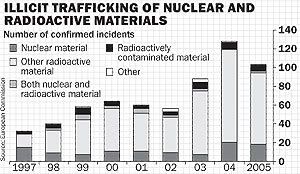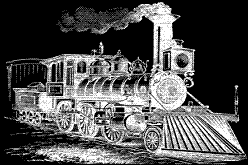Seizures of Radioactive Materials Fuel 'Dirty Bomb' Fears
By Lewis Smith
October 6, 2006
 Seizures of smuggled radioactive material capable of making a terrorist “dirty bomb” have doubled in the past four years, according to official figures seen by The Times.
Seizures of smuggled radioactive material capable of making a terrorist “dirty bomb” have doubled in the past four years, according to official figures seen by The Times.
Smugglers have been caught trying to traffick dangerous radioactive material more than 300 times since 2002, statistics from the International Atomic Energy Agency (IAEA) show. Most of the incidents are understood to have occurred in Europe.
The disclosures come as al-Qaeda is known to be intensfiying its efforts to obtain a radoactive device. Last year, Western security services, including MI5 and MI6, thwarted 16 attempts to smuggle plutonium or uranium. On two occasions small quantities of highly enriched uranium were reported missing. All were feared to have been destined for terror groups.
Scientists responsible for analysing the seizures have given warning that traffickers are turning to hospital X-ray equipment and laboratory supplies as an illicit source of radioactive material.
Investigators believe that the smugglers, who come mainly from the former Eastern bloc, are interested only in making a swift fortune and believe that they may have no compunction in selling to jihadist groups. Most undercover operations and recent seizures have been kept secret to protect the activities of Western security services.
Rigorous controls on nuclear processors, especially with Russia co-operating to stop the trafficking of enriched plutonium and uranium, have limited smugglers’ access to weapons-grade nuclear materials. But medical and laboratory sources, including waste, remain vulnerable. Such radioactive waste can be used to make a dirty bomb.
A dirty bomb combines a conventional explosive, such as dynamite, with radioactive material such as spent nuclear fuel like highly enriched uranium and plutonium. In most instances the conventional explosive would kill more bystanders but the dispersion of the radioactive material would have a hugely damaging “fear” factor.
There were 103 cases of illicit trafficking last year, compared with fewer than 30 in 1996. Fifty-eight incidents were reported in 2002, rising to 90 in 2003 and 130 in 2004. Experts point out that seizures in the past three years equal the same amount of trafficking in the previous seven years.
Olli Heinonen, deputy director-general of the IAEA, which monitors trafficking and inspects nuclear plants to audit their radioactive materials, said that while weapons-grade nuclear material smuggling was now rare there were serious concerns about other radioactive substances.
“A dirty bomb is something that needs to be taken seriously. We need to be prepared for anything because anything could happen,” he said. “Terrorists look for the weakest link. We need to be alert and we need to be prepared.”
Al-Qaeda makes no secret of its desire to obtain a dirty bomb. Last month its leader in Iraq, Abu Hamza alMuhajer, called for scientists to join it and experiment with radioactive devices for use against coalition troops. Even before 9/11, Osama bin Laden invited two Pakistani atomic scientists to visit a training camp in Afghanistan to discuss how to assemble a bomb using stolen plutonium. Captured al-Qaeda leaders have since confessed to the CIA of their attempts to smuggle a radioactive device into the US.
Professor Klaus Lützenkir-chen, who helps to analyse the seized substances, said that even small quantities of radio-active material could be of use to terrorists.
“If someone gets hold of it, it is possible it could be used in a dirty bomb,” he said. He added that if such a dirty bomb were detonated in a town centre the physical effect would be comparatively small and unlikely to cause huge loss of life but would have an enormously damaging “fear factor”.
One of the most serious seizures since 9/11 was that of several kilograms of a radioactive substance known as yellow cake that was found in a consignment of scrap metal at the port of Rotterdam in December 2003.
Professor Lützenkirchen said that seizures have been made across Europe, usually at borders and sea ports. Most of the trafficked material originated from the Caucasus region where he said that there was “considerable activity” among smugglers.
Seizures have continued this year, though overall figures for 2006 are not yet available. They include the discovery in Germany of a small quantity of highly enriched uranium.
High-level representatives from the US, Britain, France, Germany, China and Russia will meet today in London, where they are expected to refer the Iranian nuclear case to the UN Security Council after a defiant Tehran refused to suspend uranium enrichment.
October 6, 2006
 Seizures of smuggled radioactive material capable of making a terrorist “dirty bomb” have doubled in the past four years, according to official figures seen by The Times.
Seizures of smuggled radioactive material capable of making a terrorist “dirty bomb” have doubled in the past four years, according to official figures seen by The Times.Smugglers have been caught trying to traffick dangerous radioactive material more than 300 times since 2002, statistics from the International Atomic Energy Agency (IAEA) show. Most of the incidents are understood to have occurred in Europe.
The disclosures come as al-Qaeda is known to be intensfiying its efforts to obtain a radoactive device. Last year, Western security services, including MI5 and MI6, thwarted 16 attempts to smuggle plutonium or uranium. On two occasions small quantities of highly enriched uranium were reported missing. All were feared to have been destined for terror groups.
Scientists responsible for analysing the seizures have given warning that traffickers are turning to hospital X-ray equipment and laboratory supplies as an illicit source of radioactive material.
Investigators believe that the smugglers, who come mainly from the former Eastern bloc, are interested only in making a swift fortune and believe that they may have no compunction in selling to jihadist groups. Most undercover operations and recent seizures have been kept secret to protect the activities of Western security services.
Rigorous controls on nuclear processors, especially with Russia co-operating to stop the trafficking of enriched plutonium and uranium, have limited smugglers’ access to weapons-grade nuclear materials. But medical and laboratory sources, including waste, remain vulnerable. Such radioactive waste can be used to make a dirty bomb.
A dirty bomb combines a conventional explosive, such as dynamite, with radioactive material such as spent nuclear fuel like highly enriched uranium and plutonium. In most instances the conventional explosive would kill more bystanders but the dispersion of the radioactive material would have a hugely damaging “fear” factor.
There were 103 cases of illicit trafficking last year, compared with fewer than 30 in 1996. Fifty-eight incidents were reported in 2002, rising to 90 in 2003 and 130 in 2004. Experts point out that seizures in the past three years equal the same amount of trafficking in the previous seven years.
Olli Heinonen, deputy director-general of the IAEA, which monitors trafficking and inspects nuclear plants to audit their radioactive materials, said that while weapons-grade nuclear material smuggling was now rare there were serious concerns about other radioactive substances.
“A dirty bomb is something that needs to be taken seriously. We need to be prepared for anything because anything could happen,” he said. “Terrorists look for the weakest link. We need to be alert and we need to be prepared.”
Al-Qaeda makes no secret of its desire to obtain a dirty bomb. Last month its leader in Iraq, Abu Hamza alMuhajer, called for scientists to join it and experiment with radioactive devices for use against coalition troops. Even before 9/11, Osama bin Laden invited two Pakistani atomic scientists to visit a training camp in Afghanistan to discuss how to assemble a bomb using stolen plutonium. Captured al-Qaeda leaders have since confessed to the CIA of their attempts to smuggle a radioactive device into the US.
Professor Klaus Lützenkir-chen, who helps to analyse the seized substances, said that even small quantities of radio-active material could be of use to terrorists.
“If someone gets hold of it, it is possible it could be used in a dirty bomb,” he said. He added that if such a dirty bomb were detonated in a town centre the physical effect would be comparatively small and unlikely to cause huge loss of life but would have an enormously damaging “fear factor”.
One of the most serious seizures since 9/11 was that of several kilograms of a radioactive substance known as yellow cake that was found in a consignment of scrap metal at the port of Rotterdam in December 2003.
Professor Lützenkirchen said that seizures have been made across Europe, usually at borders and sea ports. Most of the trafficked material originated from the Caucasus region where he said that there was “considerable activity” among smugglers.
Seizures have continued this year, though overall figures for 2006 are not yet available. They include the discovery in Germany of a small quantity of highly enriched uranium.
High-level representatives from the US, Britain, France, Germany, China and Russia will meet today in London, where they are expected to refer the Iranian nuclear case to the UN Security Council after a defiant Tehran refused to suspend uranium enrichment.




0 Comments:
Post a Comment
<< Home